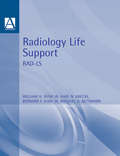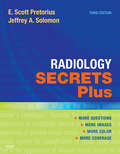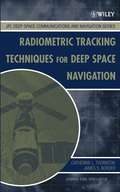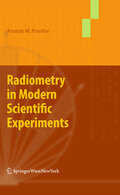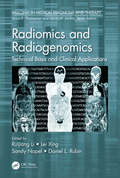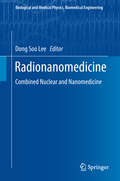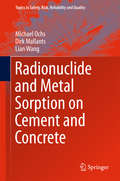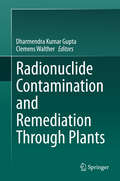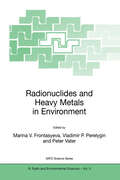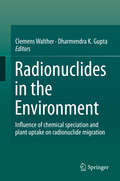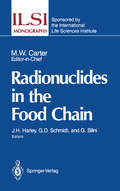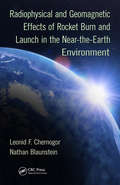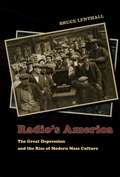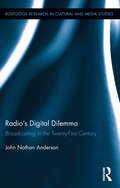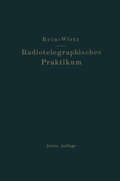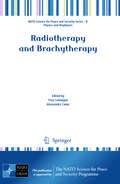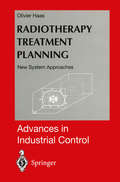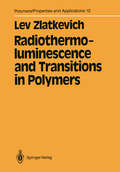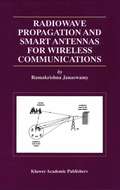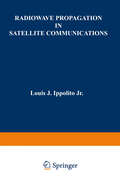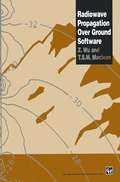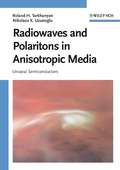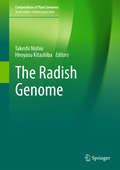- Table View
- List View
Radiology Life Support (RAD-LS): A Practical Approach
by William Bush Jr'Radiology Life Support' focuses on the adverse effects and life-threatening emergencies caused by reactions to the contrast media used in every modern radiology department. Such reactions are relatively infrequent yet can be severe and are therefore difficult to identify and then handle safely without training. All radiologists will experience at least a few such reactions throughout their career. This book teaches proper recognition and treatment of adverse contrast reactions, proper use of sedation and analgesic agents, proper management of an airway in an emergency situation and principle concepts in basic and advanced life support (including early defibrilation). The text is based on the successful training course run by the editors and sponsored by the American Roentgen Ray Society. Adverse reactions to contrast agents are somewhat difficult for physicians without practice to identify and then handle effectively. This volume is a useful aid to the identification process.
Radiology Secrets Plus E-Book: Radiology Secrets Plus (Secrets)
by E. Scott Pretorius Jeffrey A. SolomonRadiology Secrets Plus—a Secrets Series title in the new PLUS format—offers an easy-to-read, information-at-your-fingertips approach to radiology. Drs. E. Scott Pretorius and Jeffrey A. Solomon provide the expert perspective you need to grasp the nuances of this specialty. This new edition offers more information and expanded full color visual elements to provide an overall enhanced learning experience. All this, along with the popular question-and answer approach, makes it a perfect concise board review tool and a handy clinical reference.Maintains the popular and trusted Secrets Series® format, using questions and short answers for effective and enjoyable learning. Provides the most current overview and authoritative coverage of all topics thanks to contributions from an impressive list of experts in the field of radiology. Introduces the new PLUS format, with an expanded size and layout and full color for easier review, more information, and more visual elements for an overall enhanced experience.Provides the current standards of radiology practice through thorough updates to every chapter that reflect the most up-to-date information.Contains more, larger images (including new full color PET and CT images), to offer a clearer picture of what is seen is practice.
Radiometric Tracking Techniques for Deep-Space Navigation
by Catherine L. Thornton James S. BorderRadiometric Tracking Techniques for Deep-Space Navigation focuses on a broad array of technologies and concepts developed over the last four decades to support radio navigation on interplanetary spacecraft. In addition to an overview of Earth-based radio navigation techniques, the book includes a simplified conceptual presentation of each radiometric measurement type, its information content, and the expected measeurement accuracy. The methods described for both aquiring and calibrating radiometric measurements also provide a robust system to support guidance and navigation for future robotic space exploration.
Radiometry in Modern Scientific Experiments
by Pravilov AnatolyThe reader is provided with information about methods of calibration of light sources and photodetectors as well as responsiveness of spectral instruments ranging from near infrared to vacuum UV spectral, 1200 – 100 nm, and radiation intensities of up to several quanta per second in absolute and arbitrary units. The author describes for the first time original methods of measurements they created and draws upon over 40 years of experience in working with light sources and detectors to provide accurate and precise measurements. This book is the first to cover these aspects of radiometry and is divided into seven chapters that examine information about terminology, units, light sources and detectors, methods, including author’s original ones, of absolute calibration of detectors, spectral instruments responsiveness, absolute measurements of radiation intensity of photoprocesses, and original methods of their study. Of interest to researchers measuring; luminescence spectra, light intensities from IR to vacuum UV, spectral range in wide-light intensity ranges, calibrate light sources and detectors, absolute or relative quantum yields of photoprocess determination.
Radiomics and Radiogenomics: Technical Basis and Clinical Applications (Imaging in Medical Diagnosis and Therapy)
by Ruijiang Li Lei Xing Sandy Napel Daniel L. RubinRadiomics and Radiogenomics: Technical Basis and Clinical Applications provides a first summary of the overlapping fields of radiomics and radiogenomics, showcasing how they are being used to evaluate disease characteristics and correlate with treatment response and patient prognosis. It explains the fundamental principles, technical bases, and clinical applications with a focus on oncology. The book’s expert authors present computational approaches for extracting imaging features that help to detect and characterize disease tissues for improving diagnosis, prognosis, and evaluation of therapy response. This book is intended for audiences including imaging scientists, medical physicists, as well as medical professionals and specialists such as diagnostic radiologists, radiation oncologists, and medical oncologists. Features Provides a first complete overview of the technical underpinnings and clinical applications of radiomics and radiogenomics Shows how they are improving diagnostic and prognostic decisions with greater efficacy Discusses the image informatics, quantitative imaging, feature extraction, predictive modeling, software tools, and other key areas Covers applications in oncology and beyond, covering all major disease sites in separate chapters Includes an introduction to basic principles and discussion of emerging research directions with a roadmap to clinical translation
Radiomics and Radiogenomics: Technical Basis and Clinical Applications (Imaging in Medical Diagnosis and Therapy)
by Ruijiang Li, Lei Xing, Sandy Napel and Daniel L. RubinRadiomics and Radiogenomics: Technical Basis and Clinical Applications provides a first summary of the overlapping fields of radiomics and radiogenomics, showcasing how they are being used to evaluate disease characteristics and correlate with treatment response and patient prognosis. It explains the fundamental principles, technical bases, and clinical applications with a focus on oncology. The book’s expert authors present computational approaches for extracting imaging features that help to detect and characterize disease tissues for improving diagnosis, prognosis, and evaluation of therapy response. This book is intended for audiences including imaging scientists, medical physicists, as well as medical professionals and specialists such as diagnostic radiologists, radiation oncologists, and medical oncologists. Features Provides a first complete overview of the technical underpinnings and clinical applications of radiomics and radiogenomics Shows how they are improving diagnostic and prognostic decisions with greater efficacy Discusses the image informatics, quantitative imaging, feature extraction, predictive modeling, software tools, and other key areas Covers applications in oncology and beyond, covering all major disease sites in separate chapters Includes an introduction to basic principles and discussion of emerging research directions with a roadmap to clinical translation
Radionanomedicine: Combined Nuclear and Nanomedicine (Biological and Medical Physics, Biomedical Engineering)
by Dong Soo LeeThis book describes radionanomedicine as an integrated medicine using exogenous and endogenous This book describes radionanomedicine as an integrated approach that uses exogenous and endogenous nanomaterials for in vivo and human applications. It comprehensively explains radionanomedicine comprising nuclear and nanomedicine, demonstrating that it is more than radionanodrugs and that radionanomedicine also takes advantage of nuclear medicine using trace technology, in which miniscule amounts of materials and tracer kinetic elucidate in vivo biodistribution. It also discusses exogenous nanomaterials such as inorganic silica, iron oxide, upconversion nanoparticles and quantum dots or organic liposomes labelled with radioisotopes, and radionanomaterials used for targeted delivery and imaging for theranostic purposes. Further, it examines endogenous nanomaterials i.e. extracellular vesicles labelled with radioisotopes, known as radiolabelled extracellular vesicles, as well as positron emission tomography (PET) and single photon emission computed tomography (SPECT), which elucidate the biodistribution and potential for therapeutic success.
Radionuclide and Metal Sorption on Cement and Concrete (Topics in Safety, Risk, Reliability and Quality #29)
by Michael Ochs Dirk Mallants Lian WangCementitious materials are being widely used as solidification/stabilisation and barrier materials for a variety of chemical and radioactive wastes, primarily due to their favourable retention properties for metals, radionuclides and other contaminants. The retention properties result from various mineral phases in hydrated cement that possess a high density and diversity of reactive sites for the fixation of contaminants through a variety of sorption and incorporation reactions. This book presents a state of the art review and critical evaluation of the type and magnitude of the various sorption and incorporation processes in hydrated cement systems for twenty-five elements relevant for a broad range of radioactive and industrial wastes. Effects of cement evolution or ageing on sorption/incorporation processes are explicitly evaluated and quantified. While the immobilisation of contaminants by mixing-in during hydration is not explicitly addressed, the underlying chemical processes are similar. A quantitative database on the solid/liquid distribution behaviour of radionuclides and other elements in hydrated cement systems is established on the basis of a consistent review and re-evaluation of literature data. In addition to recommended values, all underlying original experimental data and key experimental information are provided, which allows users to trace the given recommendations or to develop their own set of key values. This database is closely tied to the safety analysis of near surface disposal of radioactive waste in Belgium. It focuses on radioelements, toxic stable elements and heavy metals, which makes it relevant for investigations involving the interaction of radioactive and conventional contaminants with cement-based barriers.
Radionuclide Contamination and Remediation Through Plants
by Dharmendra Kumar Gupta Clemens WaltherThis book focuses on the mechanistic (microscopic) understanding of radionuclide uptake by plants in contaminated soils and potential use of phytoremediation. The key features concern radionuclide toxicity in plants, how the radioactive materials are absorbed by plants, and how the plants cope with the toxic responses. The respective chapters examine soil classification, natural plant selection, speciation of actinides, kinetic modeling, and case studies on cesium uptake after radiation accidents.Radionuclide contaminants pose serious problems for biological systems, due to their chemical toxicity and radiological effects. The processes by which radionuclides can be incorporated into vegetation can either originate from activity interception by external plant surfaces (either directly from the atmosphere or from resuspended material), or through uptake of radionuclides via the root system. Subsequent transfer of toxic elements to the human food chain is a concrete danger. Therefore, the molecular mechanisms and genetic basis of transport into and within plants needs to be understood for two reasons: The effectiveness of radionuclide uptake into crop plants – so-called transfer coefficient – is a prerequisite for the calculation of dose due to the food path. On the other hand, efficient radionuclide transfer into plants can be made use of for decontamination of land – so-called phytoremediation, the direct use of living, green plants for in situ removal of pollutants from the environment or to reduce their concentrations to harmless levels.
Radionuclides and Heavy Metals in Environment (NATO Science Series: IV: #5)
by Marina V. Frontasyeva Vladimir P. Perelygin Peter VaterThis volume entitled "Radionuclides and Heavy Metals in Environment" contains the Proceedings of the NATO Advanced Research Workshop (ARW) "Monitoring of Natural and Man-Made Radionuclides and Heavy Metal Waste in Environment" that was held at the Joint Institute for Nuclear Research (JlNR), Dubna, Russia from 3 October to 6 October, 2000. Originally, it was planned to held the ARW in 1999, the year when NATO was celebrating its 50th anniversary. Few days before opening it had to be postponed because of problems in issuing visa for all the colleagues who intended to participate. The ARW was organized and conducted by the co-directors Prof. Vladimir P. Perelygin, Joint Institute for Nuclear Research, Dubna, Russia and Dr. Peter Vater, Philipps Universitat, Marburg, Germany. The JlNR was chosen as the host institute of ARW because of the lack of contact and real co-operation between the former Soviet Union (FSU) countries specialists in ecology and their Western well experienced colleagues. The selection of this location and supplementary funds provided by Russian Foundation on Basic Research, Moscow, Russia, and the JINR, Dubna., Russia made it possible to attain a rather large number of participants and observers from FSU countries. The JlNR provided to all the participants of the workshop an effective car/minibus transportation Moscow-Dubna-Moscow and a rather good accommodation in Dubna.
Radionuclides in the Environment: Influence of chemical speciation and plant uptake on radionuclide migration (Radionuclides and Heavy Metals in the Environment)
by Clemens Walther Dharmendra K. GuptaThis book provides extensive and comprehensive information to researchers and academicians who are interested in radionuclide contamination, its sources and environmental impact. It is also useful for graduate and undergraduate students specializing in radioactive-waste disposal and its impact on natural as well as manmade environments.A number of sites are affected by large legacies of waste from the mining and processing of radioactive minerals. Over recent decades, several hundred radioactive isotopes (radioisotopes) of natural elements have been produced artificially, including 90Sr, 137Cs and 131I. Several other anthropogenic radioactive elements have also been produced in large quantities, for example technetium, neptunium, plutonium and americium, although plutonium does occur naturally in trace amounts in uranium ores. The deposition of radionuclides on vegetation and soil, as well as the uptake from polluted aquifers (root uptake or irrigation) are the initial point for their transfer into the terrestrial environment and into food chains. There are two principal deposition processes for the removal of pollutants from the atmosphere: dry deposition is the direct transfer through absorption of gases and particles by natural surfaces, such as vegetation, whereas showery or wet deposition is the transport of a substance from the atmosphere to the ground by snow, hail or rain. Once deposited on any vegetation, radionuclides are removed from plants by the airstream and rain, either through percolation or by cuticular scratch. The increase in biomass during plant growth does not cause a loss of activity, but it does lead to a decrease in activity concentration due to effective dilution. There is also systemic transport (translocation) of radionuclides within the plant subsequent to foliar uptake, leading the transfer of chemical components to other parts of the plant that have not been contaminated directly.
Radionuclides in the Food Chain (ILSI Monographs)
by Melvin W. CarterThe Symposium on Radionuclides in the Food Chain, sponsored by the Interna tional Life Sciences Institute in association with the International Institute for Applied Systems Analysis, was intended to bring together policymakers and other representatives of the food industry with radiation experts involved in measuring and assessing radioactivity in foodstuffs. The symposium was made timely by the problems arising from the nuclear reactor accident at Chernobyl, in the USSR, which brought out the lack of international agreement on guidance for responding to such radionuclide contamination of food and foodstuffs. The presentations by the radiation experts covered the sources of radionu clides-natural radioactivity, fallout from nuclear weapons tests, routine releases from nuclear facilities, and various nuclear accidents. The speakers represented a broad distribution in both scientific disciplines and international geographic origin. They summarized the available data on measurements and indicated the current procedures for assessing radiation exposure. It was hoped that the food industry representatives would bring out the problems posed to industry and governments by the presence of radioactivity in food.
Radiophysical and Geomagnetic Effects of Rocket Burn and Launch in the Near-the-Earth Environment
by Leonid F. Chernogor Nathan BlaunsteinRadiophysical and Geomagnetic Effects of Rocket Burn and Launch in the Near-the-Earth Environment describes experimental and theoretical studies on the effects of rocket burns and launchings on the near-the-Earth environment and geomagnetic fields. It illuminates the main geophysical and radiophysical effects on the ionosphere and magnetosphere sur
Radio's America: The Great Depression and the Rise of Modern Mass Culture (Studies In Communication, Media, And Public Opinion Ser.)
by Bruce LenthallOrson Welles’s greatest breakthrough into the popular consciousness occurred in 1938, three years before Citizen Kane, when his War of the Worlds radio broadcast succeeded so spectacularly that terrified listeners believed they were hearing a genuine report of an alien invasion—a landmark in the history of radio’s powerful relationship with its audience. In Radio’s America, Bruce Lenthall documents the enormous impact radio had on the lives of Depression-era Americans and charts the formative years of our modern mass culture. Many Americans became alienated from their government and economy in the twentieth century, and Lenthall explains that radio’s appeal came from its capability to personalize an increasingly impersonal public arena. His depictions of such figures as proto-Fascist Charles Coughlin and medical quack John Brinkley offer penetrating insight into radio’s use as a persuasive tool, and Lenthall’s book is unique in its exploration of how ordinary Americans made radio a part of their lives. Television inherited radio’s cultural role, and as the voting tallies for American Idol attest, broadcasting continues to occupy a powerfully intimate place in American life. Radio’s America reveals how the connections between power and mass media began.
Radio's Digital Dilemma: Broadcasting in the Twenty-First Century (Routledge Research in Cultural and Media Studies #60)
by John Nathan AndersonRadio's Digital Dilemma is the first comprehensive analysis of the United States’ digital radio transition, chronicling the technological and policy development of the HD Radio broadcast standard. A story laced with anxiety, ignorance, and hubris, the evolution of HD Radio pitted the nation’s largest commercial and public broadcasters against the rest of the radio industry and the listening public in a pitched battle over defining the digital future of the medium. The Federal Communications Commission has elected to put its faith in "marketplace forces" to govern radio’s digital transition, but this has not been a winning strategy: a dozen years from its rollout, the state of HD Radio is one of dangerous malaise, especially as newer digital audio distribution technologies fundamentally redefine the public identity of "radio" itself. Ultimately, Radio’s Digital Dilemma is a cautionary tale about the overarching influence of economics on contemporary media policymaking, to the detriment of notions such as public ownership and access to the airwaves—and a call for media scholars and reformers to engage in the continuing struggle of radio’s digital transition in hopes of reclaiming these important principles.
Radio's Digital Dilemma: Broadcasting in the Twenty-First Century (Routledge Research in Cultural and Media Studies)
by John Nathan AndersonRadio's Digital Dilemma is the first comprehensive analysis of the United States’ digital radio transition, chronicling the technological and policy development of the HD Radio broadcast standard. A story laced with anxiety, ignorance, and hubris, the evolution of HD Radio pitted the nation’s largest commercial and public broadcasters against the rest of the radio industry and the listening public in a pitched battle over defining the digital future of the medium. The Federal Communications Commission has elected to put its faith in "marketplace forces" to govern radio’s digital transition, but this has not been a winning strategy: a dozen years from its rollout, the state of HD Radio is one of dangerous malaise, especially as newer digital audio distribution technologies fundamentally redefine the public identity of "radio" itself. Ultimately, Radio’s Digital Dilemma is a cautionary tale about the overarching influence of economics on contemporary media policymaking, to the detriment of notions such as public ownership and access to the airwaves—and a call for media scholars and reformers to engage in the continuing struggle of radio’s digital transition in hopes of reclaiming these important principles.
Radiotelegraphisches Praktikum: Neudruck 1927
by H. Rein K. WirtzDieser Buchtitel ist Teil des Digitalisierungsprojekts Springer Book Archives mit Publikationen, die seit den Anfängen des Verlags von 1842 erschienen sind. Der Verlag stellt mit diesem Archiv Quellen für die historische wie auch die disziplingeschichtliche Forschung zur Verfügung, die jeweils im historischen Kontext betrachtet werden müssen. Dieser Titel erschien in der Zeit vor 1945 und wird daher in seiner zeittypischen politisch-ideologischen Ausrichtung vom Verlag nicht beworben.
Radiotherapy and Brachytherapy (NATO Science for Peace and Security Series B: Physics and Biophysics)
by Yves Lemoigne Alessandra CanerThis book reports the majority of lectures given during the NATO Advanced Study Institute ASI-982996, which was held at the European Scientific Institute of Archamps (ESI, Archamps – France) from November 15 to November 27, 2007. The ASI course was structured in two parts: the first was dedicated to what is often called “teletherapy”, i. e. radiotherapy with external beams, while the second focused on internal radiotherapy, also called “brachytherapy” or “curietherapy” in honour of Madame Curie who initiated the technique about a century ago. This ASI took place after the European School of Medical Physics, which devoted a 3 week period to medical imaging, a subject complementary to the topics of this book. Courses devoted to nuclear medicine and digital imaging techniques are collected in two volumes of the NATO Science Series entitled “Physics for Medical Imaging Applications” (ISBN 978-1-4020-5650-5) and “Molecular imaging: computer reconstruction and practice” (ISBN 978-1-4020- 8751-6). Every year in autumn ESI organises the European School of Medical Physics, which covers a large spectrum of topics ranging from Medical Imaging to Radiotherapy, over a period of 5 weeks. Thanks to the Cooperative Science and Technology sub-programme of the NATO Science Division, weeks four and five were replaced this year by the ASI course dedicated to “Physics of Modern Radiotherapy & Brachytherapy”. This allowed the participation of experts and students from 20 different countries, with diverse cultural background and p- fessional experience.
Radiotherapy Treatment Planning: New System Approaches (Advances in Industrial Control)
by Olivier C. HaasAn in depth examination of many of the complex issues associated with planning and optimisation of intensity modulated radiotherapy treatment. It includes: a presentation of current practice, techniques and equipment used by medical physicists and others to deliver radiotherapy treatment; a systems modelling approach in the formulation of a beam model for optimisation, describing the effect of X-rays on human body tissues; a deterministic approach to the inverse problem in radiotherapy, based on weighted iterative least squares is modified to allow an adaptive scaling of the error to improve the performance of a general least squares algorithm; a guided random search methodology, based on genetic algorithms which is aimed at solving multi-objective optimisation problems is developed to optimise beam weight/wedge angle as well as coplanar beam orientation; the overall approach developed is demons trated practically using both traditional and modern measurement techniques.
Radiothermoluminescence and Transitions in Polymers (Polymers - Properties and Applications #12)
by Lev ZlatkevichRadiowave Propagation and Smart Antennas for Wireless Communications (The Springer International Series in Engineering and Computer Science #599)
by Ramakrishna JanaswamyThis book emerged from teaching a graduate level course in propagation and smart antennas at the Naval Postgraduate School. In its present form, it is suitable not only as a graduate level text, but also as a reference book for industry and research use. The area of radiowave propagation and smart antennas is highly interdisciplinary, extracting material from electromagn- ics, communications, and signal processing. This book is useful to workers in electromagnetics who would like to supplement their background with relevant communicational aspects and to workers in communications who would like to supplement their background with relevant electromagnetic aspects. Anyone with a basic understanding of probability, wave propagation, digital com- nications, and elementary signal processing should be able to appreciate the contents of the book. The book consists of nine chapters with several worked out examples d- persed throughout. Chapter 1 covers the basics of cellular communications. Chapter 2 covers the basic principles of electromagnetic wave propagation relevant to path loss predictions in wireless communications. Students with little prior background in electromagnetics should find the first few sections of Chapter 2 self-sufficient. Empirical path loss models that are used in system design are treated in Chapter 3. The chapter includes the traditional models as well as some of the newer models. Chapter 4 has a thorough discussion on the causes and characterization of small scale fading. The topic of spatial c- relation that is very important for antenna arrays is discussed there in detail.
Radiowave Propagation in Satellite Communications
by Louis J. IppolitoRadiowave Propagation in Communications was written with two basic objec tives: (l) to present an up-to-date review of the major radiowave propagation phenomena which hinder reliable space communications, and (2) to describe how these propagation phenomena affect the design and performance of satellite communications systems. Earth-orbiting satellites are employed extensively for the relay of information in a vast array of telecommunications, meteorological, government, and sci entific applications. Satellite systems rely on the transmission of radiowaves to and from the satellite and are dependent on the propagation characteristics of the transmission path, primarily the earth's atmosphere. Radiowave propagation thus plays a very important part in the design and ultimate performance of space communications systems. This book presents, for the first time, the meshing in a single publication of the fundamentals of radiowave propagation factors with a discussion of the practical consequences of these factors on satellite communications systems. Two major subfie1ds are involved in this book. Radiowave propagation, which is basically applied electromagnetic theory, provides the theory and an alytical tools for the first several chapters. Later chapters then apply propagation effects to the field of electrical engineering involved with satellite communi cations. The material progresses from the essential aspects of radiowave prop agation to the application of practical methods and techniques in the design and performance of satellite communications systems.
Radiowave Propagation Over Ground Software
by J. MacleanThe purpose of the package is to answer the question 'What is the radio field strength at a certain point?' when power is radiated from a transmit ting source. Because of the complexity of the question in general, it can only be answered at present in certain idealized situations. Nevertheless it is valuable to have quantitative data available for these situations. The package is divided into two parts. In the first of these, propagation in free space and over a flat earth are dealt with. In the second, propagation over a spherical earth is considered. In the free-space situation the power density of the signal in a given direction will fall as the inverse square of the distance from the source. For propagation from a transmitting source at an arbitrary height above a perfecdy conducting flat earth, the field strength at large distances can be 3 dB higher than in free space. With a finite conduc tivity earth, the field strength will be lower than this because of the power dissipation in the earth.
Radiowaves and Polaritons in Anisotropic Media: Uniaxial Semiconductors
by Roland H. Tarkhanyan Nikolaos K. UzunogluDivided into four main sections, this monograph presents the theory of propagation and excitation of volume and surface electromagnetic waves in anisotropic polar and nonpolar conducting crystals, together with the effects of external magnetic and strong electric fields. It also investigates the spectrum of bulk, as well as surface phonon-plasmon polaritons in uniaxial semiconductors, and electromagnetic instabilities leading to the generation and amplification of radiowaves. Additional topics include total transmission, magnon-plasmon polaritons, and the influence of hot 2D carriers. This unparalleled systematic treatment includes novel research on special topics in the field, such as the peculiarities of the polaritons in anisotropic semiconductors in the presence of mobile charge carriers.
The Radish Genome (Compendium of Plant Genomes)
by Takeshi Nishio Hiroyasu KitashibaThis book summarizes the latest information and the status quo of radish genome studies to stimulate innovations and improvements in breeding techniques and to promote further advances in the field.Radish (Raphanus sativus) is a member of the Brassicaceae family and is cultivated worldwide. Its varieties have been diversified in terms of size, shape, and the color of their roots and bio-components. Thanks to the development of high-throughput molecular techniques using next generation sequencers, complete genomes of cultivated and wild radish plants have been sequenced and published with annotations of predicted genes and single nucleotide polymorphism (SNP) information between radish cultivars and accessions. These, together with the construction of a high-density genetic map of radish and profiling of expression sequences in radish organs, have accelerated genetic studies, such as the identification of genes or loci associated with root development, pungent components, and plant disease resistance. Providing an overview of these advances, this book is a valuable resource for scientists involved in plant genetic research and crop breeding.
